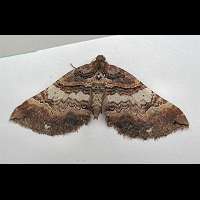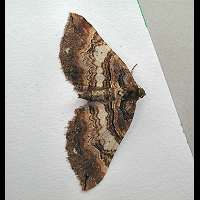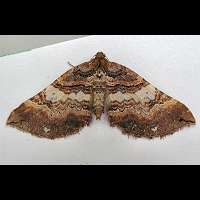Shoulder Stripe (Anticlea badiata)
Like some other Geometers the Shoulder Stripe is hard to describe: a brownish moth with brown, black, grey, yellow and white speckles, spots, bigger and smaller bands and wavy lines. Luckily there is no need to describe it in detail, for there is no other species like it. Besides this is not a very variable species. There is however a striking difference between males and females, for males are much darker and more contrasting than females. The animal in the pictures presented here is a female. The wingspan of both is some 32 to 35 mm.
The eggs are deposited in April and May. Either one by one or in pairs. This happens on a bud, but frequently on a twig near a bud. The caterpillars hatch after 10 days and find their own way to the leaves. Those larvae may be green or brown. On top is a broad line running from head to tail. This line is usually green or blackish brown. On the sides are white speckles and a line of black dots just below the middle, also running from head to tail. The head is reddish brown, sometimes very pale brown and has two dark spots on the 'cheeks'. They only feed during the night and reach a length of some 26 mm. In the beginning of july the caterpillars move to the soil and spin a cocoon. This cocoon is strengthened by adding earth and very small pebbles. In the cocoon the animal pupates. It overwinters as pupa. The larva feeds on dog-rose and other wild roses, even though sometimes a caterpillar is found on cultivated roses.
It flies about in just one generation, usually in March and April.The Shoulder Stripe is on the wing in early evening and starts flying around sunset. Frequent visitor of artificial lights. A common species in most of Britain. In Northern Scotland and the Hebrides a rather local species. In other parts of Europe a local species with scattered distribution.
Like some other Geometers the Shoulder Stripe is hard to describe: a brownish moth with brown, black, grey, yellow and white speckles, spots, bigger and smaller bands and wavy lines. Luckily there is no need to describe it in detail, for there is no other species like it. Besides this is not a very variable species. There is however a striking difference between males and females, for males are much darker and more contrasting than females. The animal in the pictures presented here is a female. The wingspan of both is some 32 to 35 mm.
The eggs are deposited in April and May. Either one by one or in pairs. This happens on a bud, but frequently on a twig near a bud. The caterpillars hatch after 10 days and find their own way to the leaves. Those larvae may be green or brown. On top is a broad line running from head to tail. This line is usually green or blackish brown. On the sides are white speckles and a line of black dots just below the middle, also running from head to tail. The head is reddish brown, sometimes very pale brown and has two dark spots on the 'cheeks'. They only feed during the night and reach a length of some 26 mm. In the beginning of july the caterpillars move to the soil and spin a cocoon. This cocoon is strengthened by adding earth and very small pebbles. In the cocoon the animal pupates. It overwinters as pupa. The larva feeds on dog-rose and other wild roses, even though sometimes a caterpillar is found on cultivated roses.
It flies about in just one generation, usually in March and April.The Shoulder Stripe is on the wing in early evening and starts flying around sunset. Frequent visitor of artificial lights. A common species in most of Britain. In Northern Scotland and the Hebrides a rather local species. In other parts of Europe a local species with scattered distribution.






